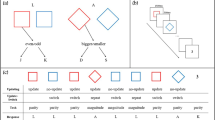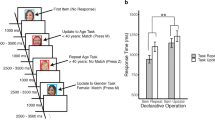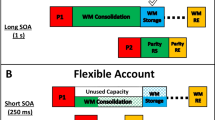Abstract
Theoretical models suggest that maintenance and updating are two functional states of working memory (WM), which are controlled by a gate between perceptual information and WM representations. Opening the gate enables updating WM with input, while closing it enables keeping the maintained information shielded from interference. However, it is still unclear when gate opening takes place, and what is the external signal that triggers it. A version of the AX-CPT paradigm was used to examine a recent proposal in the literature, suggesting that updating is triggered whenever the maintenance of the context is necessary for task performance (context-dependent tasks). In four experiments using this paradigm, we show that (1) a task-switching cost takes place in both context-dependent and context-independent trials; (2) task-switching is additive to the dependency effect, and (3) unlike switching cost, the dependency effect is not affected by preparation and, therefore, does not reflect context-updating. We suggest that WM updating is likely to be triggered by a simple mechanism that occurs in each trial of the task regardless of whether maintaining the context is needed or not. The implications for WM updating and its relationship to task-switching are discussed.





Similar content being viewed by others
Notes
The sample size varied between the experiments. Experiment 1 was a replication of D’Ardenne et al.’s study, and served for a proof of concept towards the following experiments. Experiments 2 and 3 were designed to enable a more fine-grained analysis, and hence included more participants. N was larger in Experiment 4 to compensate for the smaller reliability of the measurement, compared to Experiments 1–3, due the smaller number of trials per condition.
This variable is typically termed “task-rule congruency” in the task-switching literature (Meiran & Kessler, 2008). We decided to keep the term “dependency” in order to be consistent with D’Ardenne and colleagues’ paper terminology.
It should be noted that a CTI of 750 ms is typically considered to be relatively long in the task-switching literature. While acknowledging this fact, this interval was selected in order to remain as close as possible to the original paradigm, in which (unlike most task-switching experiments) the cue disappears for 500 ms before the probe is presented. Accordingly, a 750 ms CTI involves a cue presentation for 250 ms, plus the 500 ms interval.
References
Baddeley, A., Chincotta, D., & Adlam, A. (2001). Working memory and the control of action: evidence from task switching. Journal of Experimental Psychology General, 130, 641–657.
Badre, D. (2012). Opening the gate to working memory. PNAS, 109, 19878–19879.
Braver, T. S. (2012). The variable nature of cognitive control: a dual mechanisms framework. Trends in Cognitive Sciences, 16, 106–113.
Braver, T. S., & Cohen, J. D. (2000). On the control of control: the role of dopamine in regulating prefrontal function and working memory. In S. Monsell & J. Driver (Eds.), Attention and performance XVIII: control of cognitive processes (pp. 713–737). Cambridge: MIT Press.
Bromberg-Martin, E. S., Matsumoto, M., & Hikosaka, O. (2010). Dopamine in motivational control: rewarding, aversive, and alerting. Neuron, 68, 815–834.
Bunting, M., Cowan, N., & Saults, J. S. (2006). How does running memory span work? Quarterly Journal of Experimental Psychology, 59, 1691–1700.
Cowan, N. (2001). The magical number 4 in short-term memory: a reconsideration of mental storage capacity. Behavioral and Brain Sciences, 24, 114–185.
D’Ardenne, K., Eshel, N., Luka, J., Lenartowicz, A., Nystrom, L. E., & Cohen, J. D. (2012). Role of prefrontal cortex and the midbrain dopamine system in working memory updating. Proceedings of the National Academy of Science USA, 109, 19900–19909.
Dayan, P. (2012). How to set the switches on this thing. Current Opinion in Neurobiology, 22, 1068–1074.
Dreisbach, G., & Wenke, D. (2011). The shielding function of task sets and its relaxation during task switching. Journal of Experimental Psychology Learning Memory and Cognition, 37, 1540–1546.
Ecker, U. K., Lewandowsky, S., & Oberauer, K. (2014). Removal of information from working memory: a specific updating process. Journal of Memory and Language, 74, 77–90.
Ecker, U. K. H., Lewandowsky, S., Oberauer, K., & Chee, A. E. H. (2010). The components of working memory updating: an experimental decomposition and individual differences. Journal of Experimental Psychology Learning Memory and Cognition, 36, 170–189.
Fiore, F., Borella, E., Mammarella, I. C., & De Beni, R. (2012). Age differences in verbal and visuo-spatial working memory updating: evidence from analysis of serial position curves. Memory, 20, 14–27.
Frank, M. J., Loughry, B., & O’Reilly, R. C. (2001). Interactions between frontal cortex and basal ganglia in working memory: a computational model. Cognitive Affective and Behavioral Neuroscience, 1, 137–160.
Friedman, N. P., Miyake, A., Corley, R. P., Young, S. E., Defries, J. C., & Hewitt, J. K. (2006). Not all executive functions are related to intelligence. Psychological Science, 17, 172–179.
Garavan, H. (1998). Serial attention within working memory. Memory Cognition, 26, 263–276.
Goldman-Rakic, P. S. (1987). Circuitry of the prefrontal cortex and the regulation of behavior by representational memory. In V. B. Mountcastle, F. Plum, & S. R. Geiger (Eds.), Handbook of neurobiology (pp. 373–417). Bethesda: American Physiological Society.
Gray, J. R., Chabris, C. F., & Braver, T. S. (2003). Neural mechanisms of general fluid intelligence. Nature Neuroscience, 6, 316–322.
Hazy, T. E., Frank, M. J., & O’Reilly, R. C. (2007). Towards an executive without a homunculus: computational models of the prefrontal cortex/basal ganglia system. Philosophical Transactions of the Royal Society B, 362, 1601–1613.
Hommel, B. (1998). Event files: evidence for automatic integration of stimulus-response episodes. Visual Cognition, 5, 183–216.
Kane, M. J., Conway, A. R., Miura, T. K., & Colflesh, G. J. (2007). Working memory, attention control, and the N-back task: a question of construct validity. Journal of Experimental Psychology Learning Memory and Cognition, 33, 615–622.
Kessler, Y., & Meiran, N. (2006). All updateable objects in working memory are updated whenever any of them is modified: evidence from the memory updating paradigm. Journal of Experimental Psychology Learning Memory and Cognition, 32, 570–585.
Kessler, Y., & Meiran, N. (2008). Two dissociable updating processes in working memory. Journal of Experimental Psychology Learning Memory and Cognition, 34, 1339–1348.
Kessler, Y., & Meiran, N. (2010). The reaction-time task-rule congruency effect (RT-TRCE) is not affected by working memory load: further support for the activated long-term memory hypothesis. Psychological Research, 74, 388–399.
Kessler, Y., & Oberauer, K. (2014). The time for updating working memory reflects the cost of switching between stability and flexibility mode. Journal of Experimental Psychology Learning Memory and Cognition, 40, 738–754.
Kessler, Y., & Oberauer, K. (2015) Forward scanning in verbal working memory updating. Psychonomic Bulletin Review. (in press).
Kiesel, A., Stenhauser, M., Wendt, M., Falkenstein, M., Jost, K., Philipp, A. M., & Koch, I. (2010). Control and interference in task switching—a review. Psychological Bulletin, 136, 849–874.
Logan, G. D., & Bundesen, C. (2003). Clever homunculus: is there an endogenous act of control in the explicit task-cuing procedure? Journal of Experimental Psychology Human Perception and Performance, 29, 575–599.
Luck, S. J., & Vogel, E. K. (1997). The capacity of visual working memory for features and conjunctions. Nature, 390, 279–281.
Masson, M. E. J., & Loftus, G. R. (2003). Using confidence intervals for graphically based data interpretation. Canadian Journal of Experimental Psychology, 57, 203–220.
Mayr, U., Kuhns, D., & Hubbard, J. (2014). Long-term memory and the control of attentional control. Cognitive Psychology, 72, 1–26.
Meiran, N. (2000). The reconfiguration of the stimulus task-set and the response task set during task switching. In S. Monsell & J. Driver (Eds.), Attention and performance XVIII: control of cognitive processes (pp. 377–400). Cambridge: MIT Press.
Meiran, N., & Daichman, A. (2005). Advance task preparation reduces task error rate in the cueing task-switching paradigm. Memory and Cognition, 33, 1272–1288.
Meiran, N., Hsieh, S., & Dimov, E. (2010). Resolving task rule incongruence during task switching by competitor rule suppression. Journal of Experimental Psychology Learning Memory and Cognition, 36, 992–1002.
Meiran, N., & Kessler, Y. (2008). The task rule congruency effect in task switching reflects activated long-term. Journal of Experimental Psychology Human Perception and Performance, 34, 137–157.
Miller, E. K., & Cohen, J. D. (2001). An integrative theory of prefrontal cortex function. Annual Review of Neuroscience, 24, 167–202.
Miyake, A., & Friedman, N. P. (2012). The nature and organization of individual differences in executive functions: four general conclusions. Current Directions in Psychological Science, 21, 8–14.
Miyake, A., Friedman, N. P., Emerson, M. J., Witzki, A. H., Howerter, A., & Wager, T. D. (2000). The unity and diversity of executive functions and their contributions to complex “frontal lobe” tasks: a latent variable analysis. Cognitive Psychology, 41, 49–100.
Monsell, S. (2003). Task switching. Trends in Cognitive Sciences, 7, 134–140.
Monsell, S., & Mizon, G. A. (2006). Can the task-cuing paradigm measure an endogenous task-set reconfiguration process? Journal of Experimental Psychology Human Perception and Performance, 32, 493–516.
Morris, N., & Jones, D. M. (1990). Memory updating in working memory: the role of the central executive. British journal of psychology, 81, 111–121.
Norman, D. A., & Shallice, T. (1986). Attention to action: willed and automatic control of behavior. In R. J. Davidson, G. E. Schwartz, & D. Shapiro (Eds.), Consciousness and self-regulation: advances in research and theory (Vol. 4, pp. 1–18). New York: Plenum.
O’Reilly, R. C. (2006). Biologically based computational models of high-level cognition. Science, 314, 91–94.
O’Reilly, R. C., & Frank, M. J. (2006). Making working memory work: a computational model of learning in the prefrontal cortex and basal ganglia. Neural Computation, 18, 283–328.
Oberauer, K. (2001). Removing irrelevant information from working memory: a cognitive aging study with the modified Sternberg task. Journal of Experimental Psychology Learning Memory and Cognition, 27, 948–957.
Oberauer, K. (2002). Access to information in working memory: exploring the focus of attention. Journal of Experimental Psychology Learning Memory and Cognition, 28, 411–421.
Oberauer, K., Souza, A. S., Druey, M., & Gade, M. (2013). Analogous mechanisms of selection and updating in declarative and procedural working memory: experiments and a computational model. Cognitive Psychology, 66, 157–211.
Palladino, P., & Jarrold, C. (2008). Do updating tasks involve updating? Evidence from comparisons with immediate serial recall. Quarterly Journal of Experimental Psychology, 61, 392–399.
Pollack, I., Johnson, L. B., & Knaff, P. R. (1959). Running memory span. Journal of Experimental Psychology, 57, 137–146.
Ruiz, M., Elosúa, M. R., & Lechuga, M. T. (2005). Old-fashioned responses in an updating memory task. Quarterly Journal of Experimental Psychology, 58, 887–908.
Schultz, W., Dayan, P., & Montague, P. R. (1997). A neural substrate of prediction and reward. Science, 275, 1593–1597.
Szmalec, A., Verbruggen, F., Vandierendonck, A., & Kemps, E. (2011). Control of interference during working memory updating. Journal of Experimental Psychology Human Perception and Performance, 37, 137–151.
Vandierendonck, A., Liefooghe, B., & Verbruggen, F. (2010). Task switching: interplay of reconfiguration and interference control. Psychological Bulletin, 136, 601–626.
Wise, R. A. (2004). Dopamine, learning and motivation. Nature Reviews Neuroscience, 5, 483–494.
Yamaguchi, M., & Proctor, R. W. (2011). Automaticity without extensive training: the role of memory retrieval in implementation of task-defined rules. Psychonomic Bulletin Review, 18, 347–354.
Acknowledgments
This research has received funding from the European Union Seventh Framework Programme (FP7/2007–2013) under Grant agreement no. PCIG09-GA-2011-293832 awarded to the first author.
Author information
Authors and Affiliations
Corresponding author
Rights and permissions
About this article
Cite this article
Kessler, Y., Baruchin, L.J. & Bouhsira-Sabag, A. Working memory updating occurs independently of the need to maintain task-context: accounting for triggering updating in the AX-CPT paradigm. Psychological Research 81, 191–203 (2017). https://doi.org/10.1007/s00426-015-0717-2
Received:
Accepted:
Published:
Issue Date:
DOI: https://doi.org/10.1007/s00426-015-0717-2




